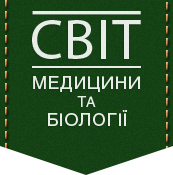| Список цитованої літератури |
- Borzykh OA, Lavrenko AV, Avramenko YM, Kaidashev SP. Indyvidualnyy pidkhid do likuvannya khvorykh na tsukrovyy diabet 2 typu z suputnyoyu patolohiyeyu vnutrishnikh orhaniv: materials All-Ukrainian. interdisciplinary scientific-practical conf. with international participation “UMSA a century of innovative directions and scientific achievements (to the 100th anniversary of the UMSA)” (Poltava, October 8, 2021). Problems of ecology and medicine. 2021; 25(3–4): 7. [in Ukrainian]
- Britton KA, Massaro JM, Murabito JM, Kreger BE, Hoffmann U, Fox CS. Body fat distribution, incident cardiovascular disease, cancer, and all-cause mortality. J. Am. Coll. Cardiol. 2013; 62(10): 921–925. doi: 10.1016/j.jacc.2013.06.027.
- Burton JO, Gray LJ, Webb DR, Davies MJ, Khunti K, Crasto W, et al. Association of anthropometric obesity measures with chronic kidney disease risk in a non-diabetic patient population. Nephrol Dial Transplant. 2012; 27(5): 1860–1866. doi: 10.1093/ndt/gfr574.
- Chawla R, Madhu SV, Makkar BM, Ghosh S, Saboo B, Kalra S. RSSDI-ESI Clinical Practice Recommendations for the Management of Type 2 Diabetes Mellitus 2020 Rajeev On behalf of the RSSDI-ESI Consensus Group Indian. J Endocrinol Metab. 2020; 24(1): 1–122. doi: 10.4103/ijem.IJEM_225_20.
- Chen Y, Zhang N, Sun G, Guo X, Yu S, Yang H, et al. Metabolically healthy obesity also has risk for hyperuricemia among Chinese general population: A cross-sectional study. Obes Res Clin Pract. 2016; 10(1): 84–95. doi: 10.1016/j.orcp.2016.03.008.
- Gariballa S, Kosanovic M, Yasin J, El Essa A. Oxidative damage and inflammation in obese diabetic Emirati subjects. Nutrients. 2014; 6(11): 4872–4880. doi: 10.3390/nu6114872.
- Goldani H, Adami FS, Antunes MT, Rosa LH, Fassina P, Quevedo Grave MT, et al. Applicability of the visceral adiposity index (VAI) in the prediction of the components of the metabolic syndrome in elderly. Nutricion Hospitalaria. 2015; 32: 1609–1615. doi: 10.3305/nh.2015.32. 4.9589.
- Jiang J, Cui J, Yang X, Wang A, Mu Y, Dong L, et al. Neck circumference, a novel indicator for hyperuricemia. Front Physiol. 2017; 8: 965. doi: 10.3389/fphys.2017.00965.
- Kleber ME, Delgado G, Grammer TB, Silbernagel G, Huang J, Krämer BK, et al. Uric Acid and Cardiovascular Events: A Mendelian Randomization Study. J. Am. Soc. Nephrol. 2015; 26: 2831–2838. doi: 10.1681/ASN.2014070660.
- Motamed N, Khonsari MR, Rabiee B, Ajdarkosh H, Hemasi GR, Sohrabi MR, et al. Discriminatory ability of visceral adiposity index (VAI) in diagnosis of metabolic syndrome: a population based study. Exp Clin Endocrinol. 2017; 125(3): 202–207. doi: 10.1055/s-0042-119032.
- Peng TC, Wang CC, Kao TW, Chan JY, Yang YH, Chang YW, et al. Relationship between hyperuricemia and lipid profles in US adults. BioMed. Res. Int. 2015; 127596. doi: 10.1155/2015/127596
- Qing L, Wei R, Chan L, Xiaoya Z, Xin X. Sensitivity of various body indices and visceral adiposity index in predicting metabolic syndrome among Chinese patients with adult growth hormone deficiency. J Endocrinol Investig. 2017; 40(6): 653–661. doi: 10.1007/s40618-017-0621-2.
- Von Lueder TG, Girerd N, Atar D, Agewall S, Lamiral Z, Kanbay M, et al. High-Risk Myocardial Infarction Database Initiative Investigators. Serum uric acid is associated with mortality and heart failure hospitalizations in patients with complicated myocardial infarction: findings from the High-Risk Myocardial Infarction Database Initiative. Eur. J. Heart Fail. 2015; 17: 1144-1151. doi: 10.1002/ejhf.419
- Yang Y, Feng Y, Ma X, Chen K, Wu N, Wang D, et al. Visceral adiposity index and insulin secretion and action in first-degree relatives of subjects with type 2 diabetes. J. Diabetes Metab Res Rev. 2015; 31(3): 315-321. doi: 10.1002/dmrr.2615.
- Zhang N, Chang Y, Guo X, Chen Y, Ye N, Sun Y. A body shape index and body roundness index: two new body indices for detecting association between obesity and hyperuricemia in rural area of China. Eur J Intern Med. 2016; 29: 32-36. doi: 10.1016/j.ejim.2016.01.019.
|
